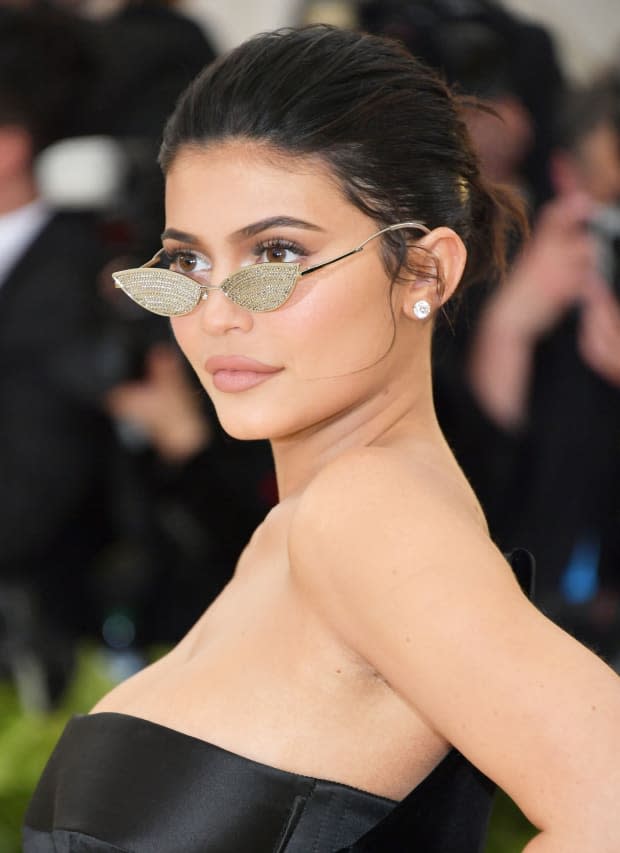What Happens When a Plastic Surgery Trend Dies?
The collective attention span of the aesthetically-minded is at an all-time low, and it's all Instagram's fault.

Pre-social media, designers focused on two heavy-hitting collections per year and magazines fed the fashion-hungry with trend reports in monthly installments. Now, your feed serves up style inspiration multiple times a day — and it's influencing more than the shade of lipstick you buy or the shoe trend you try. More and more women (and men) are choosing to alter their physical features in ways both temporary and permanent, based on the latest Instagram look.
In fact, of all the previously unfathomable realities that the social media platform has given the world — the possibility of a career as an influencer, laxative teas with more celebrity clout than the latest It Bag — perhaps the most far-reaching is "Instagram face." You know, the homogenous mix of trendy facial features and/or body parts that make for the perfect storm of #selfie likability. Think Blake Lively's nose mixed with Kylie Jenner's lips and Emily Ratajkowski's breasts.
"Patients will come in requesting certain enhancements, especially lips, based on what they see on Instagram," Dr. Paul Jarrod Frank, a celebrity cosmetic dermatologist and founder of the PFrankMD Skin Salons, tells Fashionista. "It does create a certain frenzy in the pursuit of perfection that is not realistic." Not to mention, subject to change. What happens when today's trend becomes tomorrow's #TBT? When Jenner stops getting lip injections, or Lady Gaga's gorgeous nose becomes the ideal du jour?
This isn't necessarily a new question — beauty standards have been evolving since the beginning of time, albeit at a slower pace, and celebrities have always been a source of body modification inspiration. In the '90s, Pamela Anderson's oversize breast implants buoyed the big-boob movement, and it's only in the past handful of years that smaller breasts have fallen into fashion.

"I am seeing a lot of patients coming in to remove their 'too-big' breast implants and opting for smaller sizes, a lift (the 'model breast') or fat injections to give just a bit of volume to the top of the breast," says Dr. Sheila Nazarian, a board certified plastic surgeon in Beverly Hills.
In more recent history, Jenner single-handedly supported the injectables industry after she made the decision to get fillers in 2015. "It was maybe four or five years ago when I started seriously thinking about getting lip injections and how the procedure could enhance my lip shape," says Taylor Osumi, a public relations professional in the beauty space. That was right about the time when Jenner's influence started to spread. Social media impacted Osumi's decision in another way, too: "I meticulously researched reputable dermatologists and RNs who are known for injections on Instagram, and even started saving Instagram photos of the lip shape and volume I wanted to achieve," she says.
Dr. Nazarian similarly credits Instagram for its positive effect on plastic surgery. "I have seen a lot of younger patients in the office as a result of social media," the surgeon says. "They are more transparent and open to talking about what they are getting done because of these online platforms, and I think this has helped to somewhat lift the taboo of getting cosmetic work done."
It's true — the taboo of cosmetic surgery has never been less of a thing. But since clients aren't as concerned with making small, discrete changes, there's a greater risk for going overboard. "For a new lip filler patient, I ask them what an ideal pair of lips would look like for them, and we look at pictures together to make sure that we share a common aesthetic," Dr. Summit Kundaria, a plastic surgeon with Nuance Facial Plastics in North Carolina, tells Fashionista. "If their ideal is overfilled lips, then we have an honest discussion about how our goals do not line up, and that they are better finding a practitioner who shares their aesthetic ideals."
Dr. Kundaria is especially wary of over-doing it with a patient since revisions — i.e., fixing the not-quite-right work of another surgeon or cosmetic dermatologist — account for roughly 10 percent of his practice, a statistic that Dr. Frank and Dr. Nazarian echo. "Most often, it involves dissolving filler," Dr. Kundaria says.
The phrase "dissolving filler" is a little misleading; it gives the impression that filler can just be dissolved away once you're over the look of lip injections — which is what Jenner did in July of 2018, kickstarting a new trend of natural-looking lips. But it's not that simple.
"What people don't realize is that overly plump lips are not just something to play around with, as the fillers are expanding the tissues as they get over-filled," Dr. Kundaria explains. "What requires one syringe of filler today may require one and a half in a few years, as the lips are expanding." Eventually, lips can expand so much that they need to be surgically reduced. "This is the same issue with cheek fillers," he says. "Too much expands the tissues, and starts a cycle of over-filling and deflation until the tissues relax and need more invasive procedures to correct years of missteps."
Surgeons estimate that that the rate of corrective lip surgeries may soon rise for a number of reasons: For one, patients are starting younger; and the longer they use fillers, the more likely it is that they’ll need to remedy expansion in the future. Two, the large lip look is on its way out.
As for what’s in? Tear trough fillers (injections just under the under-eye bags) and chin liposuction — both a result of the sometimes-dreaded tagged photo feature on Instagram, according to Dr. Kundaria. "People that have a lot of pictures taken of them come in more for tear trough fillers, which can look deeper in certain lighting situations, and chin liposuction, as the 'double chin' is usually not present in selfies," he says.
Apparently, the selfie-obsessed have a different set of concerns. "Most often, people that take a lot of selfies feel that their nose is larger, and this is due to the distortion due to perspective," says the plastic surgeon. "As pictures are taken from a closer distance to the subject, certain features are emphasized relative to others."
This rings true for one rhinoplasty recipient Fashionista spoke with, who wished to remain anonymous. "Social media was on the rise at the time I started considering surgery, and I knew there would be photos in college," she says. Post-nose job, "I don't even think about angles now when taking pictures."
Admittedly, nose jobs are less "trend-driven" than modifications like lip and cheek fillers — smaller, upturned noses have long been idealized in Western culture. But can't be ignored that celebrities and social media have had a huge hand in perpetuating this standard; many have clearly had rhinoplasty procedures, and plenty of them admit to it openly. But as conversations about inclusivity and diversity come to the fore, things are changing. The past few years have seen a call for more inclusive representation in the media, including a wider range of body types, skin colors, backgrounds and yes, facial features. But unfortunately, rhinoplasty is one body modification that can't be reversed.
"I looked exactly like Ashlee Simpson at the time before her nose job — think 'Pieces of Me' Ashlee — and once she did her nose, I realized I could have that too, and it was too tempting to pass up," Zoey Greco, a spiritual coach, tells Fashionista. Even though she's happy with her new nose, Greco maintains she "regrets it on some level. I think if there had been anyone that looked like me and was celebrated, I would have felt beautiful."

Plenty of people who've gone under the knife are thrilled with the results, but the permanence of rhinoplasty does bring up a deeper issue for some: what to do when kids enter the picture. "I want to have kids in the future and don't think I'll be sharing my plastic surgery story with them, because I don't want them to feel the family pressure that I felt," a source, who wished to remain anonymous, tells Fashionista. "Bumps" run in her family, and the fact that her mother and cousins had nose jobs to "fix" the genetic feature heavily influenced her decision. "If one of [my children] wants to change something, I'll support that, but I don't want to sway them," the source says. "I was 19 when I did it, and I'm not sure I would make the same decision now at 29."
The sentiment was echoed by another anonymous source who shared, "I am certainly going to do my best to ensure that my daughter never wants to undergo major surgery in order to feel pretty, but of course, if she did, I would be the first to understand."
Through this lens, the question of "What happens when a plastic surgery trend dies?" isn't one that's easily answered — because it's not just the hyper-speed cycle of social media that’s influencing our future aesthetic preferences. There's also the far-reaching impact of permanent cosmetic surgeries, which may perpetuate fragments of today's beauty standards for generations to come, to consider. The one given? There will always be another trend, another feature to obsess over… and you can't necessarily pin that on Instagram.
After the satisfaction of one surgery faded, many of the sources Fashionista spoke to simply turned their focus elsewhere; which, really, is just human nature. Lip fillers precipitated cheek fillers, precipitated Botox and more — a sort of Pavlovian response to finding and fixing a supposed flaw.
"I developed BDD [body dysmorphic disorder] after my procedure, which I carry to this day," Greco says. "My nose is no longer my focus, but the rest of my body now occupies my thoughts and makes me feel inadequate." She’s decided not to have any more procedures done. "But in today's world, where fillers and Botox are so normalized, it's been a challenge," she says.
Obviously, this isn't the ideal outcome in the eyes of a cosmetic dermatologist or plastic surgeon, which is why many practitioners caution against making trend-driven decisions. "My advice for women and men considering 'trendy' procedures on Instagram would be to wait, if you can," Dr. Kundaria says. "Trends come and go, but things that actually work — a category that I think is embarrassingly small — stay around."
Never miss the latest fashion industry news. Sign up for the Fashionista daily newsletter.
